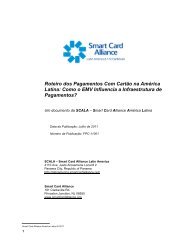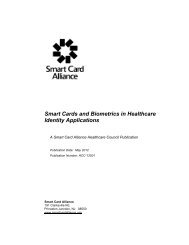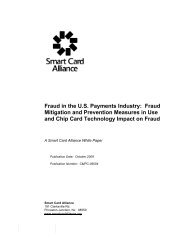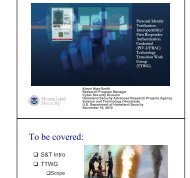PIV-I White Paper - FINAL - 022111 - Smart Card Alliance
PIV-I White Paper - FINAL - 022111 - Smart Card Alliance
PIV-I White Paper - FINAL - 022111 - Smart Card Alliance
You also want an ePaper? Increase the reach of your titles
YUMPU automatically turns print PDFs into web optimized ePapers that Google loves.
developed by international standards-setting bodies and commercial associations 12 can providean overall solution for identity credentialing efforts. States are increasingly issuing trustedelectronic identity credentials that meet these standards. States can put into place processesbased on standards that enable trust and strong electronic authentication and validation outsideof their jurisdictions, increasing the value and use of these credentials in the process.For example, Michigan, New York, Vermont, and Washington State are leading the WHTIstandards implementation effort and are using complying identity credentials for both stateidentification and for Canadian border crossings in lieu of a passport. Other states, such asVirginia, Colorado, and Pennsylvania, are issuing <strong>PIV</strong>-I identity credentials that comply with theidentity proofing and vetting standards specified in NIST SP-800-63, Electronic AuthenticationGuidance. 13 These <strong>PIV</strong>-I identity credentials are used predominantly at incident scenes as firstresponder credentials, but the credentials can also be used for digital signatures and otherfunctions requiring strong electronic authentication.CIOs and their CISOs can take advantage of the <strong>PIV</strong>-I standard. The standard clearly defines theprocess steps, roles, and responsibilities required to issue a high assurance, multi-purposeelectronic identity credential. The standards-based technology used by the credentials ensuresthe establishment of security, privacy, and trust, promoting interoperability.2.3 TechnologyTechnical interoperability of credentials depends on strong and stable standards. The <strong>PIV</strong> and<strong>PIV</strong>-I technology and infrastructure are based on standards at many levels – from the physicaltoken (the smart card) to the identity credential components to the PKI that enables interoperabletrust. <strong>PIV</strong> and <strong>PIV</strong>-I are based on FIPS 201 and accompanying special publications, andreference other internationally recognized standards. The General Services Administrationoperates independent testing procedures to validate and approve products that comply with FIPS201 and publishes the results as an Approved Products List (APL).<strong>PIV</strong>-I credentials provide secure, multi-factor authentication at the high level of assurancerequired. <strong>PIV</strong>-I combines a modern and mathematically strong authentication factor (thecryptographic private key) with a personal identification number (PIN), fingerprint biometrictemplate, and tamper-proof digital photograph. This combination provides high assurance levels,allows the cardholder to control the release of information, and provides a trusted identity that canbe used for a wide range of cyber and physical transactions.2.3.1 PKI and TrustA federated identity infrastructure imposes obligations among parties involved to establishcontractual agreements. These agreements address issues related to policies and procedures inorder to achieve a high level of assurance, trust and interoperability, such as can be provided bya cross-certified public key infrastructure as used with <strong>PIV</strong>-I.A PKI is the architecture, organization, techniques, practices, and procedures that collectivelysupport the implementation and operation of a certificate-based public key cryptographic system.Also included in a PKI are the certificate policies and agreements among parties that documentthe operating rules, procedural policies, and liabilities of the parties operating within the PKI.A PKI provides the foundation for interoperable trust. The basis for the trust is the digitalcertificate issued by a trusted third party, the certificate authority (CA). A digital certificate bindsan asymmetric public key to identity information under a particular PKI policy. Individuals use thedigital certificates in transactions. When a individual digitally signs a transaction using the12 For example, the International Civil Aviation Organization (ICAO), the American National Standards Institute(ANSI), the World Wide Web Consortium (W3C) and the Internet Engineering Task Force (IETF), among others.13 "Electronic Authentication Guidance," NIST SP 800-63, http://csrc.nist.gov/publications/nistpubs/800-63/SP800-63V1_0_2.pdf<strong>Smart</strong> <strong>Card</strong> <strong>Alliance</strong> © 20118
















